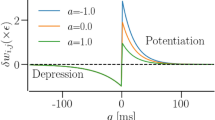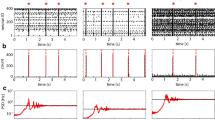Abstract
The capacity to re-establish a normal rhythm after an excitation while adapting to external or internal stimuli is a process of great complexity. We propose an agent-based framework to model the homeostatic plasticity in neuronal activity incorporating the concept of selforganization. Our model provides the ability for neuroagents to adapt themselves in a series of activities after the excitements of synaptic inputs in a similar way to the nervous system, hence allowing the creation of diversification and a competitive environment.
Similar content being viewed by others
Explore related subjects
Discover the latest articles, news and stories from top researchers in related subjects.References
Kirshbaum D (2002) Introduction to complex systems. Retrieved from http://www.calresco.org/ intro.htm#def
Burrone J, Murthy VN (2003) Synaptic gain control and homeostasis. Curr Opin Neurobiol 13:560–567
Davis GW, Bezprozvanny I (2001) Maintaining the stability of neural function: a homeostatic hypothesis. Annu Rev Physiol 63:847–869
Turrigiano GG (1999) Homeostatic plasticity in neuronal networks: the more things change, the more they stay the same. Trends Neurosci 22:221–227
Gazzaniga MS, Ivry RB, Mangun GR (2002) Cognitive neuroscience: the biology of mind, 3rd end. Chap 2, W.W. Norton & Company, NY
Davis GW (2006) Homeostatic control of neural activity: from phenomenology to molecular design. Annu Rev Neurosci 29:307–323
Vogels TP, Rajan K, Abbott LF (2005) Neural network dynamics. Rev Adv 18:15
Funahashi K, Nakamura Y (1993) Approximation of dynamical systems by continuous time recurrent neural networks. Neural Networks 6:801–806
Williams H, Noble J (2005) Homeostatic plasticity improves signal propagation in continuous-time recurrent neural networks. Biosystems 87:252–259
Williams H (2005) Homeostatic plasticity improves continuoustime recurrent neural network as a behavioral substrate. In: Proceedings of the 3rd International Symposium on Adaptive Motions in Animals and Machines, Ilmenau, Germany
Izquierdo-Torres E, Harvey I (2007) Hebbian learning using fixed weight evolved dynamical neural networks. Symposium on Artificial Life. IEEE, Honolulu, HI, pp 394–401
Fernando S, Matsuzaki S, Nakamura Y, et al (2008) Simulation of neuronal activity using molecular reaction. Proceedings of the 11th Intl Conf Human and Computer, Nagaoka, Japan, pp 189–193
Author information
Authors and Affiliations
Corresponding author
Additional information
This work was presented in part at the 14th International Symposium on Artificial Life and Robotics, Oita, Japan, February 5–7, 2009
About this article
Cite this article
Fernando, S., Matsuzaki, S. & Marasinghe, A. Modeling towards homeostatic plasticity in neuronal activities. Artif Life Robotics 14, 262 (2009). https://doi.org/10.1007/s10015-009-0667-0
Received:
Accepted:
Published:
DOI: https://doi.org/10.1007/s10015-009-0667-0




